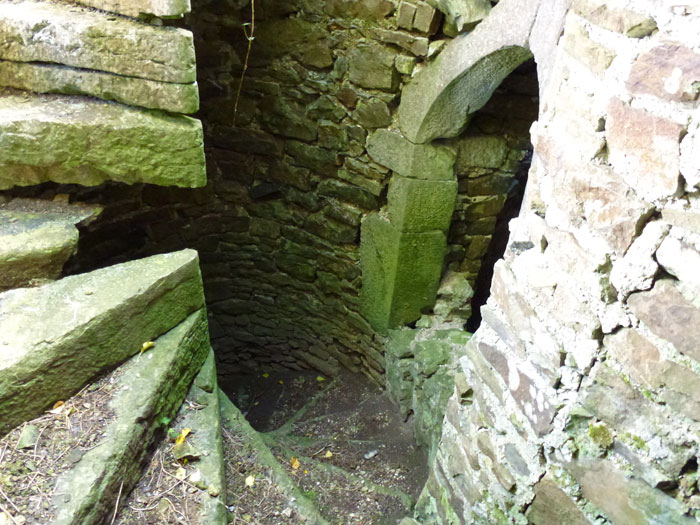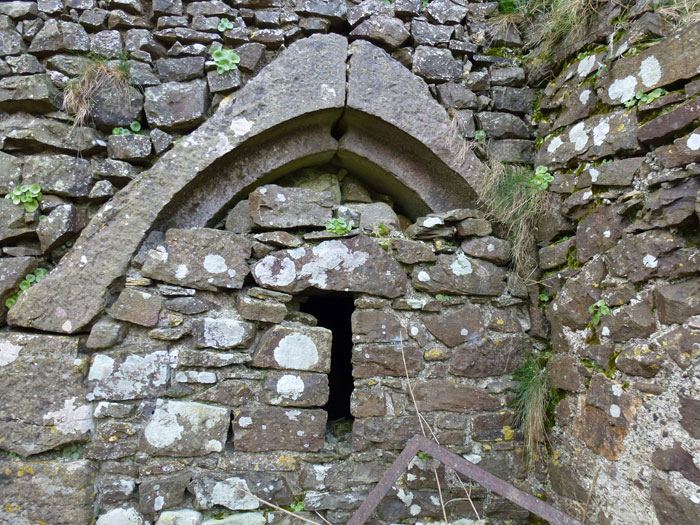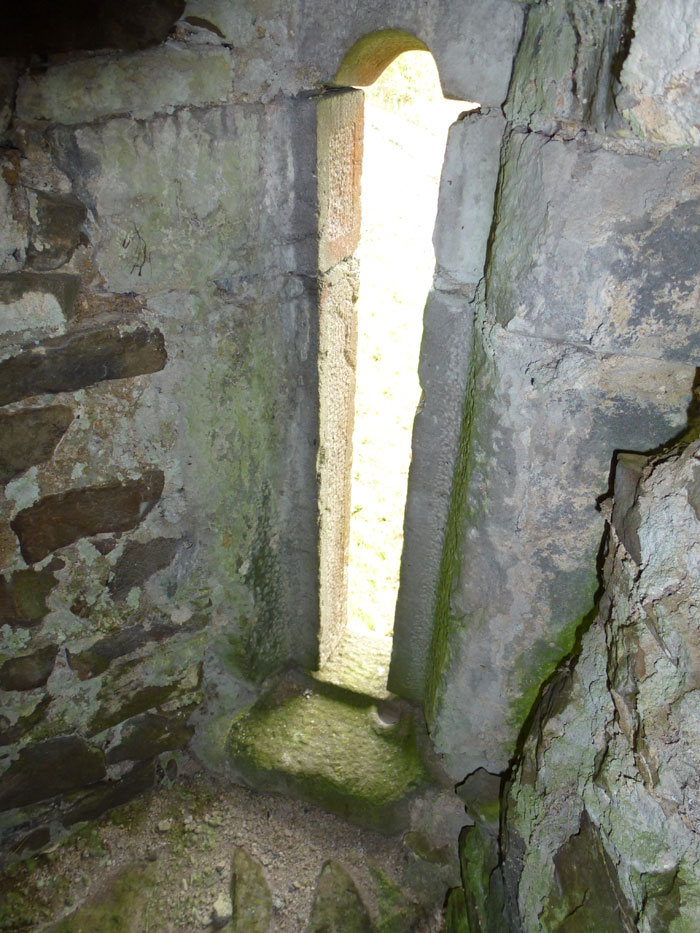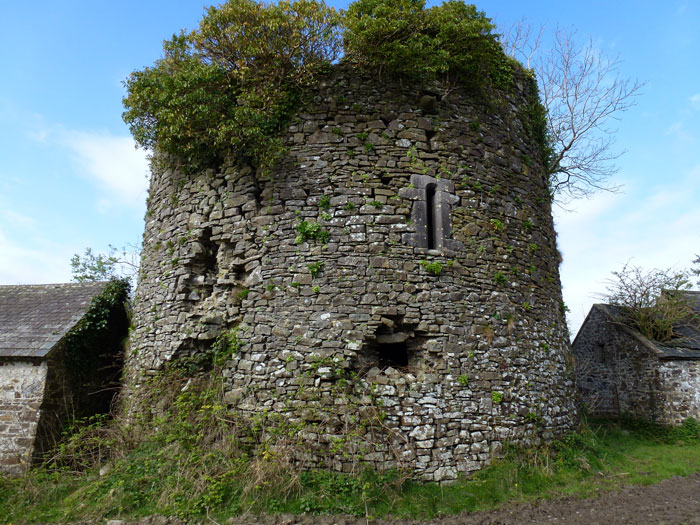Farranrory Castle
The Settlement and Architecture of Later Medieval Slieveardagh, County Tipperary.
Richard Clutterbuck – Volume II This thesis is presented in fulfilment of the regulations for the degree of M.Utt in Archaeology, University College Dublin. Head of Department: Supervisors: Prof. Barry Raftery, Dr. Tadhg O’Keeffe, Dr. Muiris 0’Sullivan, August 1998
Farranrory Tower House – Farranrory Lower Td., Ballingarry Pr.
Location: Farranrory is situated in the east of Slieveardagh on the hills overlooking the Munster River Valley. The land is used predominantly for pasture today and was estimated to be mostly pasture in 1654 (Civil Survey I, 115). The site is approximately 4.2km northeast of Ballingarry parish centre.
Farranrory castle is sited at an altitude of 210 metres on ground sloping gently to the southeast. The site has a south-easterly aspect and is sheltered by the hills. A small stream tributary of the Munster River runs approximately 40 metres to the east of the tower house cutting a small valley in the shale bed rock. The tower house is 190 metres north-west of a road which runs east-west into Co. Kilkenny. A lane connects the site to the road and probably served the original settlement and the modern farm yards and houses as well as continuing up the hill as a lane to the fields.
 History The townland of Farrenrory was owned by William Fanninge of Farrenrory in 1641 (Civil Survey I, 115). The Fannings were a wealthy land owning family in Ballingarry parish in the late medieval period. The castle was recorded as a good little castle with a good thatcht house & some cabbins (Civil Survey I, 115). The castle was depicted in the Down Survey along with five houses surrounding it. Farrenrory became the property of Lieutenant William Jessy of the Cromwellian army who is recorded with two hearth is the Hearth Tax returns for 1666/7 (Laffan 1911, 138). It is unlikely he lived in the castle itself for much time.
History The townland of Farrenrory was owned by William Fanninge of Farrenrory in 1641 (Civil Survey I, 115). The Fannings were a wealthy land owning family in Ballingarry parish in the late medieval period. The castle was recorded as a good little castle with a good thatcht house & some cabbins (Civil Survey I, 115). The castle was depicted in the Down Survey along with five houses surrounding it. Farrenrory became the property of Lieutenant William Jessy of the Cromwellian army who is recorded with two hearth is the Hearth Tax returns for 1666/7 (Laffan 1911, 138). It is unlikely he lived in the castle itself for much time.
 Description Farrenrory Castle is a free standing tower house with a circular plan. The castle is constructed of coursed limestone surviving to the level of the second floor above which it is derelict. The interior has mural chambers, a stairs and an internal vault. The exterior ground level of the structure has a very slight base batter. The gable of a derelict farm house is attached to the west side of the tower house, partially obscuring the original entrance (Fig. 45, Plate 19). The tower house has a maximum external diameter of 10.4 metres and an internal diameter of 5.2 metres for the main ground floor chamber. Farrenrory survives to an approximate height of 8 metres. None of the original woodwork or door survives in the interior of the tower house and was probably salvaged for a later building. This robbing resulted in the breach in the ground floor embrasure and also the destruction of the tower above the second floor. Farrenrory tower house has a major structural crack in its facade and may be in danger of collapse.
Description Farrenrory Castle is a free standing tower house with a circular plan. The castle is constructed of coursed limestone surviving to the level of the second floor above which it is derelict. The interior has mural chambers, a stairs and an internal vault. The exterior ground level of the structure has a very slight base batter. The gable of a derelict farm house is attached to the west side of the tower house, partially obscuring the original entrance (Fig. 45, Plate 19). The tower house has a maximum external diameter of 10.4 metres and an internal diameter of 5.2 metres for the main ground floor chamber. Farrenrory survives to an approximate height of 8 metres. None of the original woodwork or door survives in the interior of the tower house and was probably salvaged for a later building. This robbing resulted in the breach in the ground floor embrasure and also the destruction of the tower above the second floor. Farrenrory tower house has a major structural crack in its facade and may be in danger of collapse.
 The tower house was entered through pointed-arch cut limestone door located in the western quadrant of the tower. The door frame has two orders one of which accommodated a yett held in place by chains through holes in the left jamb and the apex of the door frame. The gable of the later falm house obscures the right hand side of the jamb. A dedication plaque is set in the wall above the door; unfOltunately this plaque is illegible. Presumably is a dedication to the builder and owner of the tower house, probably a member of the Fanning family. The main entrance leads to a small lobby area. Two inward opening pointed-arch doors led from the lobby to a mural chamber and a secondary lobby. There is a clUciform musket loop with downward splayed expanded terminals directly in front of the main enhance. This is set in a single flag of limestone and is reached by a recesses in the main ground floor chamber. There is also a murder hole in the lobby ceiling which drops from a mural chamber in the first floor. The small ground floor mural chamber probably acted as a guard chamber or storage space. This chamber has a vaulted roof and has two recesses in the walls for cupboard space.
The tower house was entered through pointed-arch cut limestone door located in the western quadrant of the tower. The door frame has two orders one of which accommodated a yett held in place by chains through holes in the left jamb and the apex of the door frame. The gable of the later falm house obscures the right hand side of the jamb. A dedication plaque is set in the wall above the door; unfOltunately this plaque is illegible. Presumably is a dedication to the builder and owner of the tower house, probably a member of the Fanning family. The main entrance leads to a small lobby area. Two inward opening pointed-arch doors led from the lobby to a mural chamber and a secondary lobby. There is a clUciform musket loop with downward splayed expanded terminals directly in front of the main enhance. This is set in a single flag of limestone and is reached by a recesses in the main ground floor chamber. There is also a murder hole in the lobby ceiling which drops from a mural chamber in the first floor. The small ground floor mural chamber probably acted as a guard chamber or storage space. This chamber has a vaulted roof and has two recesses in the walls for cupboard space.
Farrenrory Tower House, Farranrory Lower Td., Ballingarry Pr. The secondary entrance lobby gives access the main ground floor chamber and the vice through inward opening door set in pointed-arch limestone frames. The jambs still retain some pivot holes and hanging-eyes for the heavy wooden doors as well as the holes in the jambs for the cross bolts. The chain for the yett can also be drawn through an aperture from this lobby. The ground floor main chamber is circular in shape with coursed shale walls and three deep set embrasures for windows. The embrasure in the south-west quadrant has been broken out. The floor of the chamber is obscured by rubbish and debris from the walls and corbel roof. The chamber originally had a wooden ceiling. The embrasures are vaulted, still with the impression of the wicker-work centring. Narrow slit windows are round-headed and constructed of dressed limestone with splayed ingoings. The exterior of the southern light has carved spandrels with a triple-leaf motif. On either side of the lights are musket loops. These are deep apertures splayed at an angle to the windows, although their exits on the outside of the tower house have been removed and blocked. Portions of the vaulting of the southern embrasure have collapsed where it corresponds with the first floor embrasure overhead. The vice is accessed through an inward opening segmented pointed-arch door from the secondary lobby and was lit by a single narrow window. The first floor was reached through a pointed-arch door directly off the vice. A mural passage from the vice leads to the chamber with the murder hole. The passage is lit by slit windows and has a small gun loop next to the murder hole over the ground floor main entrance. The wooden floor of the second storey was supported on corbels. The floor has three deep embrasures each with a narrow ogee-headed windows of dressed limestone. On each side of the lights are apertures for gun loops. These pierce the wall as small circular holes created by two shaped pieces of limestone. The first floor has a vaulted ceiling which is now in a dangerous state of repair. The second floor can still be reached by the remains of the vice though some of the steps have been removed. This floor as too dangerous to inspect but appears to have been larger then the lower floors. The original walls partially survive and contain the remains of a number of windows around its circumference and a slop stone on the north-east side of this floor. The remains of the second floor are obscured by the growth of grass, ivy and a tree. The tree is probably destroying the internal vault with its roots. There is no apparent garderobe or a fire place in the tower house, although these may have been contained on the second or upper floors. There is no evidence for a bawn or wall around the tower. However, the area around the castle has been used as a farm yard with stone out-houses and these may have robbed and obscured any original bawn walls.
Comment Circular tower houses are a relatively rare form of tower house. Craig identified the distribution of cylindrical tower houses as predominantly in the east Tipperary, Kilkenny area with some in counties Clare and Cork (Craig 1982, 103). Crohane (17) was the only other example of a circular tower house in Slieveardagh; Crohane tower house is now mostly destroyed. Neither Farrenrory or Crohane were mentioned in Craig’s list of circular tower houses. Other examples of cylindrical tower houses have five floors and two intemal or domicile vaults, such as Ballynahow and Synon (Leask 1973, 108) (Fig. 7A & B). Farranrory appears to be a smaller example. Other examples of cylindrical towers sported conical roofs. There is the possibility that the tower house had a central fire place on the second or third floor, explaining the lack of a fire place and chimney in the architectural remains. The multiple gun or musket loops place this tower house in the sixteenth century when hand held guns became numerous in Ireland (McNeill 1997, 205). The site was part of a rich farmstead. The owners where the Fanning family, an important land owning family in the Ballingany area. The surrounding buildings depicted in the Down Survey were the residence of farm labourers, or simple out houses. – The END.
 We first hear of the old Norman family of Fanning in 1305, when Sir Eustace de Poer leased the Manor, Castle and lands of Mohober to William Fanning. This castle stood in the area now known as Fanning’s Bog; and the Fanning family had been in the Waterford area since they had arrived, soon after the Norman invasion. They soon began to expand and acquired lands in Ballintaggart and Ballingarry. They were no strangers to litigation noe to actual warfare. By 1332 it appears that Sir Eustace de Poar had again occupied Mohober Castle from which he was forcibly ejected by Thomas FitzGilbert Fanning. Three men were killed defending the castle and Thomas de Poar was slain. This episode was part of a power struggle in Ossory which continued for a long time and involved, on one side, Richard de Ledrede, the English Franciscan Bishop of Ossory and on the other side the rich and powerful de La Poers. The most famous episode, in the struggle was the involvement of Dame Alice Kytler the witch of Kilkenny. After Dame Alice had fled, and her principal aide had been burnt at the stake, the le Poers continued he feud, accusing the Bishop of having instigated the attack of Mohober and the murder of Thomas de Poer. However, it appreas that the Bishop and the Fannings, won the case and remained in possession. By the year 1508, they owned Ballintaggart and Gortfree and in 1508 Geoffrey son of Nicholas Fanning was described as Lord of Ballingarry. Geoffrey seems to have been a remarkable person who dominated the area for more than half a century. His name often appeared on the Jurors Lists for Tipperary. He was not always law abiding. In 1555 five men, including Geoffrey’s three sons were charged with having “advised, procured and abetted by Geoffrey Fanning, Gent, wilfully burned a house in Farrenrory containing 40 cows, worth £60, of William Fanning, Gent, and also a girl called Sawe Iny Canlyen, who was in the house”. The jurors found them guilty but we have no record of the penalty, if any. Soon afterwards Geoffrey was again a juror. By this time they had come under Butler overlordship. The Butler had purchased Mohober and Ballintaggart but the Fannings were very wealthy and powerful.
We first hear of the old Norman family of Fanning in 1305, when Sir Eustace de Poer leased the Manor, Castle and lands of Mohober to William Fanning. This castle stood in the area now known as Fanning’s Bog; and the Fanning family had been in the Waterford area since they had arrived, soon after the Norman invasion. They soon began to expand and acquired lands in Ballintaggart and Ballingarry. They were no strangers to litigation noe to actual warfare. By 1332 it appears that Sir Eustace de Poar had again occupied Mohober Castle from which he was forcibly ejected by Thomas FitzGilbert Fanning. Three men were killed defending the castle and Thomas de Poar was slain. This episode was part of a power struggle in Ossory which continued for a long time and involved, on one side, Richard de Ledrede, the English Franciscan Bishop of Ossory and on the other side the rich and powerful de La Poers. The most famous episode, in the struggle was the involvement of Dame Alice Kytler the witch of Kilkenny. After Dame Alice had fled, and her principal aide had been burnt at the stake, the le Poers continued he feud, accusing the Bishop of having instigated the attack of Mohober and the murder of Thomas de Poer. However, it appreas that the Bishop and the Fannings, won the case and remained in possession. By the year 1508, they owned Ballintaggart and Gortfree and in 1508 Geoffrey son of Nicholas Fanning was described as Lord of Ballingarry. Geoffrey seems to have been a remarkable person who dominated the area for more than half a century. His name often appeared on the Jurors Lists for Tipperary. He was not always law abiding. In 1555 five men, including Geoffrey’s three sons were charged with having “advised, procured and abetted by Geoffrey Fanning, Gent, wilfully burned a house in Farrenrory containing 40 cows, worth £60, of William Fanning, Gent, and also a girl called Sawe Iny Canlyen, who was in the house”. The jurors found them guilty but we have no record of the penalty, if any. Soon afterwards Geoffrey was again a juror. By this time they had come under Butler overlordship. The Butler had purchased Mohober and Ballintaggart but the Fannings were very wealthy and powerful.
Their Castle of Ballingarry stood near the Old Church. We can see, from the Civil Survey of 1654 how extensive were the lands they owned in 1640. They included the townlands of Ballingarry, Ballaghboy, Glengall, Grawn, Garrinohousy, Farrenrory, Cappagh, Kilmackenogue and Gortfree. Other branches held lands in Paulstown and Ballytarsny in Co. Kilkenny, in Kells and Knocktopher baronies as well as lands to the west of Killenaule and Glengoole areas. They had many branches. A Lieutenant John Fanning served in the Spanish Army under the exiled Charles 2nd and was killed at the Battle of Prague in 1648. In the same year Don Diego Fanin, a native of Ballingarry sought admission to the Order of Santiago in Spain. His parents were Don Nicholas Fanning of Ballingarry and Elena Cantwell of Moycarkey and his grandparents were William Fanning and Catelina Purcell of Ballyfoyle and John Cantwell and Margaret Morris, of Latteragh. They were members of old noble Norman families. The Purcells of Ballyfoyle were a branch of the Purcells, Barons of Loughmore and through that family, Don Diego was related to Dr. Edward Comerford, who was to become Archbishop of Cashel in 1693, a native of Harley Park. As they had sided with the Confederate side against Cromwell, all the lands were confiscated and they were offered a small estate of some 160 acreas in Fenagh, Co. Leitrim. They did not go willingly, for some at least remained as tenants of the new owner and retained some small property until well into the 18th Century. Fanning of Ballingarry tried an unsuccessful ruse to fool the Cromwellians by lighting a huge fire beside the castle and claiming it had been done by his enemies because of his loyality to the Commonwealth, but Cromwell saw through the ruse and Fanning was executed. Another story, probably apocryphal, is told of Fanning of Gortfree, who was approached by a Cromwellian officer on horseback who demanded the immediate surrender of the castle. Fanning, in fury, with one mighty blow of his sword, beheaded the Cromwellian. The horse bolted in terror, with its headless burden, into a nearby bog., where it sank completely out of sight. Many years later, or so I was told, some turf cutters found a skeleton of a horse in the bog woth the headless bones of its rider still in mouldering saddle! In 1666, Jeffrey Fanning was tenant of a house in Ballingarry and a century later one of the family gave a site to the Archbishop of Cashel for a small church. The name is now rare in the area, although common in other parts of Tipperary.
Michael J. Fitzgerald Thurles (formally Gragaugh)

